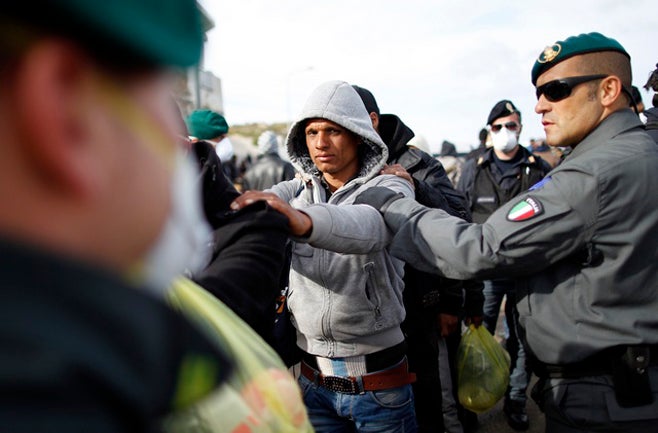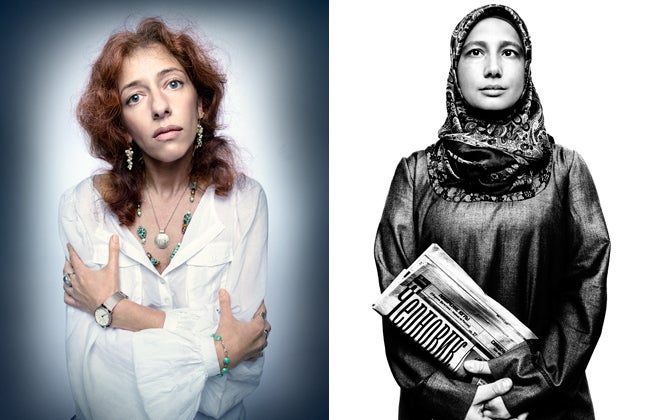2011 was a dramatic year for Libya. A popular uprising and government crackdown led to an armed revolt, NATO intervention, and the death of a dictator who had amassed a deplorable human rights record over 42 years. At this writing Libya’s new interim leadership, the National Transitional Council (NTC), was struggling to rein in the many militias and local security forces across the country, secure unguarded weapons, and build a new Libya based on independent institutions and the rule of law. A weak criminal justice system, torture and mistreatment of detainees, and revenge attacks against Gaddafi officials and supporters were pressing concerns, as was the apparent execution of Libyan leader Muammar Gaddafi, his son Muatassim, and dozens of his supporters.
The Uprising
On February 15, 2011, anti-government protests began in Libya’s second-largest city, Benghazi, following popular uprisings in neighboring Tunisia and Egypt. The protests were triggered by the arrests of government critics, including a lawyer representing the families of an estimated 1,200 prisoners who had been killed at Tripoli’s Abu Salim prison in 1996.
Government forces responded by arresting and attacking peaceful demonstrators in Benghazi and other eastern cities. The government used excessive force when protests spread to the western cities of Tripoli, the capital, Misrata, Zawiya, Zuwara, and Zintan. Human Rights Watch documented the government’s lethal use of live fire on peaceful protesters, as well as the arrest and disappearance of hundreds of people suspected of involvement in anti-government demonstrations.
The international response to Gaddafi’s crackdown was swift. On February 25 the United Nation Human Rights Council condemned “gross and systematic” violations in Libya and called for the creation of a commission of inquiry.The next day the UN Security Council unanimously passed Resolution 1970, imposing an arms embargo, sanctions on Gaddafi and key members of his family and government, and referring the situation in Libya to the International Criminal Court (ICC). The resolution gave the ICC jurisdiction over war crimes and crimes against humanity committed in Libya from February 15. In June ICC judges authorized arrest warrants for crimes against humanity against three suspects: Muammar Gaddafi, his son Saif al-Islam, and Gaddafi’s intelligence chief and brother-in-law Abdullah Sanussi. Muammar Gaddafi died on October 20, but at this writing the other two suspects remained at large.
Faced with violent government repression, the uprising rapidly evolved into an armed conflict, especially after opposition forces seized arms from abandoned government military depots in eastern Libya. On March 17, as Gaddafi’s military forces closed in on Benghazi, the key opposition stronghold, the UN Security Council passed Resolution 1973 imposing a no-fly zone over Libya and authorizing the use of “all necessary measures”—with the exception of an occupation force—to protect civilians. This led to NATO’s Operation Unified Protector, with a mandate to protect civilians, which prevented Gaddafi forces from retaking Benghazi and eastern Libya. The NATO mission expanded over time beyond its mandate to give air support for anti-Gaddafi forces. France, Qatar, the United Arab Emirates, and possibly other governments provided weapons and training to opposition fighters. Qatar later said it had deployed hundreds of its own forces on the ground.
The Armed Conflict
From February until August, when Tripoli fell, Gaddafi forces arrested thousands, if not tens of thousands, of people across the country, including anti-government protesters, suspected government critics, and people alleged to have provided information to international media and human rights organizations. Many of those arrested were fighters, but many others were civilians, including doctors, journalists, and people caught in areas where fighting took place. The Gaddafi government provided no information regarding how many people it had arrested, where they were being held, or the charges they faced. Detainees who were released from government custody during and after the conflict reported frequent torture, including beatings with wooden sticks and plastic pipes, and the use of electric shock. Some prisoners apparently died from the abuse or the subsequent lack of medical care.
In the fighting, government forces repeatedly launched indiscriminate attacks with mortars and GRAD rockets into civilian-inhabited areas, especially in Misrata and towns of the western mountains. The coastal city of Misrata suffered a two-month siege with near daily attacks that killed scores of civilians and for a while blocked delivery of humanitarian aid. Human Rights Watch confirmed the government’s use in Misrata of mortar-fired cluster munitions in residential areas, and the use of "parachute” antivehicle mines fired by GRAD rockets.
The government laid thousands, perhaps tens of thousands, of antipersonnel and antivehicle landmines in various parts of Libya, including in Ajdabiya, Brega, Misrata and the western mountains. Human Rights Watch confirmed the use of five types of landmines in six separate locations, which will likely endanger civilians for many years. The Brazilian T-AB-1 antipersonnel landmine appears to have been the most frequently used mine; its low metal content makes the mine more difficult to detect and clear.
Human Rights Watch documented 10 cases of apparent gang rape and sexual assault of men and women by Gaddafi forces during the conflict, including of detainees in custody. The extent of sexual violence during the conflict remains unknown, due in part to the stigma surrounding rape in Libya and the dangers that survivors may face when they publicize such crimes.
During the conflict, and especially just before the fall of Tripoli, Gaddafi forces executed prisoners in their custody. Members of the Khamis Brigade, a powerful military force run by Gaddafi’s son Khamis, appear to have summarily executed at least 45 detainees in a warehouse in Tripoli in August. Thirty-four bodies exhumed from a mass grave near the town of al-Qawalish in western Libya in August seemed to be those of men detained by Gaddafi forces in early June. In September the bodies of 18 detainees, who died by suffocation when detained by Gaddafi forcesin June in al-Khoms, were discovered buried in western Libya. In May security forces apparently executed 10 antigovernment protesters in Bani Walid.
At this writing Libya was still dealing with the problem of missing persons from the conflict. The number of missing and dead remains unclear. Mass graves continued to be discovered, but the lack of forensic expertise complicatedthe identification process.
Rebel forces also committed human rights and humanitarian law violations during the armed conflict. The most significant documented case came in October, when militias from Misrata appeared to have executed 53 Gaddafi supporters in Sirte.
In areas of eastern Libya under NTC control since late February and early March, volunteer security groups arbitrarily arrested dozens of suspected Gaddafi loyalists. This led to serious abuses, including torture. Human Rights Watch documented one apparent death in custody by a local security group in Baida, and heard credible reports of other such deaths. At least 10 former Gaddafi security officials were found dead in Benghazi and Derna in what appear to be revenge killings.
When the Gaddafi government retreated from the east, tens of thousands of sub-Saharan African foreign workers came under threat of violence and arbitrary arrest, forcing thousands to flee. These migrants, along with dark-skinned Libyans, were widely accused without evidence of having fought as mercenaries for Gaddafi, although mercenaries from some countries did come to fight.
In July the commander of the opposition forces, Gen. Abdul Fatah Younes, was killed with two aides in unclear circumstances. Despite promises, the authorities appear not to have conducted an independent investigation.
In the western mountains, rebel forces engaged in revenge attacks in some towns they captured, including looting, arson, and some physical violence.
As NTC forces took control of western Libya in late August, local militias arbitrarily arrested hundreds, if not thousands, more sub-Saharan migrant workers and dark-skinned Libyans from the south, accusing them of being mercenaries. In some cases, the militias subjected these detainees to physical abuse and forced labor in detention. Thousands of African migrants sought shelter in makeshift camps with very poor living conditions and security.
Prison conditions in post-Gaddafi western Libya were sub-standard, with overcrowding, inadequate food and water, and consistent reports of abuse, including beatings and some use of electric shock. The NTC has failed to provide most detainees with prompt judicial reviews, let alone access to a lawyer.
A key problem was the large number of local security forces in Tripoli and other cities and towns, many of which maintained their own makeshift detention facilities. At this writing the NTC was struggling to bring these disparate forces under a unified civilian command.
Revenge attacks against populations deemed to have supported Gaddafi also grew in September and October. In particular, militias from Misrata prevented about 30,000 people from returning to their homes in Tawergha, a town near Misrata, because they accused them of having committed atrocities in Misrata together with Gaddafi forces. Displaced Tawerghans were subject to arbitrary arrests and torture in detention, in some cases leading to death. Members of the Mesheshiya tribe in the western mountains, accused of past loyalty to Gaddafi, also reported harassment and revenge attacks.
On October 20, after weeks of fierce fighting in Sirte, NTC forces captured Muammar Gaddafi and his son Muatassim. Video footage strongly suggests that they were executed in custody. The NTC said it will form a commission of inquiry to examine the deaths.
Three days after Gaddafi’s death, Human Rights Watch found 53 bodies of apparent Gaddafi supporters outside the Mahari Hotel in Sirte, where rebel forces from Misrata had been based. Some victims had their hands bound behind their backs; they all seemed to have been shot at that location. The NTC said it will investigate.
Despite promises, the NTC had failed through October to secure some of the military weapons and munitions depots abandoned by Gaddafi forces. These stockpiles included unsecured surface-to-air missiles (SAMs) and vast amounts of explosive weapons. Many of these sites were extensively looted by civilians and armed groups.
The NTC responded positively to some requests from human rights organizations during and after the conflict, for instance by granting Human Rights Watch and other groups unrestricted access to their detention facilities. The NTC publicly promised to respect the laws of war and to cooperate with the ICC, and political leaders repeatedly condemned revenge attacks. On April 28 the NTC officially pledged not to use antipersonnel and antivehicle landmines, and to destroy all mines in its forces' possession. At the same time, NTC leaders said they had limited control over the many local militias and brigades who had committed abuses during and after the fighting.
NATO forces led by the French and British, with significant support from the United States, launched thousands of air strikes on government targets during the conflict, some of which killed civilians.Based on a partial Human Rights Watch investigation, the number of civilian deaths appeared far lower than claimed by theGaddafi government, but higher than acknowledged by NATO.
In early August Human Rights Watch investigated four sites in Gaddafi government-held territory of western Libya in which about 50 people appear to have died, some of them clearly civilians.It was not possible under the circumstances to determine at any of the sites whether these civilians had died in an unlawful NATO attack.NATO has failed to provide detailed information about these targets and the reasons for the civilian casualties. NATO forces were also accused of failing to rescue African migrants at sea who were fleeing the conflict, on one occasion leading to 63 deaths.
Key International Actors
Many countries played crucial roles in Libya in 2011, especially those who participated in the NATO campaign. Qatar and the United Arab Emirates provided significant support to the anti-Gaddafi opposition, and then to some post-Gaddafi groups. All these countries, and the European Union, have a major stake in seeing that future Libyan governments respect human rights and the rule of law. A UN mission is tasked with assisting Libya’s transition, especially democratic elections and transitional justice.
Libya’s new leaders face an enormous challenge: to build a country based on the rule of law after 42 years of one-family rule, while preventing revenge attacks, ensuring accountability for abuses by all parties to the conflict, and promoting reconciliation. All these processes will take time and will require outside assistance.But the events of 2011 have given Libyans the opportunity to begin this arduous process.






